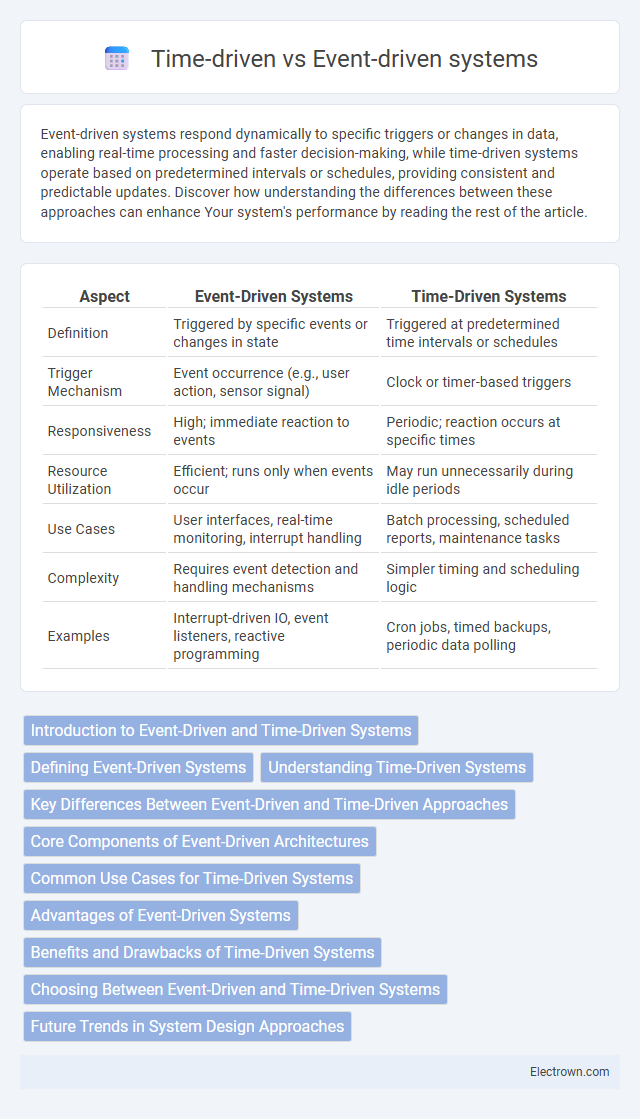Event-driven systems respond dynamically to specific triggers or changes in data, enabling real-time processing and faster decision-making, while time-driven systems operate based on predetermined intervals or schedules, providing consistent and predictable updates. Discover how understanding the differences between these approaches can enhance Your system's performance by reading the rest of the article.
Table of Comparison
| Aspect | Event-Driven Systems | Time-Driven Systems |
|---|---|---|
| Definition | Triggered by specific events or changes in state | Triggered at predetermined time intervals or schedules |
| Trigger Mechanism | Event occurrence (e.g., user action, sensor signal) | Clock or timer-based triggers |
| Responsiveness | High; immediate reaction to events | Periodic; reaction occurs at specific times |
| Resource Utilization | Efficient; runs only when events occur | May run unnecessarily during idle periods |
| Use Cases | User interfaces, real-time monitoring, interrupt handling | Batch processing, scheduled reports, maintenance tasks |
| Complexity | Requires event detection and handling mechanisms | Simpler timing and scheduling logic |
| Examples | Interrupt-driven IO, event listeners, reactive programming | Cron jobs, timed backups, periodic data polling |
Introduction to Event-Driven and Time-Driven Systems
Event-driven systems operate by responding to specific events or changes in state, triggering actions only when those events occur, which optimizes resource usage and responsiveness. Time-driven systems execute tasks at predetermined intervals or schedules regardless of external events, ensuring consistent performance and predictability. Understanding the distinction between these systems helps you choose the right approach for applications requiring either reactive behavior or regular, timed execution.
Defining Event-Driven Systems
Event-driven systems respond to specific events or changes in state, triggering actions immediately upon event detection without waiting for a predetermined time. These systems are highly efficient for real-time applications, as they process inputs asynchronously, reacting only when necessary to optimize resource use. You can leverage event-driven architectures to improve responsiveness and reduce unnecessary processing in dynamic environments.
Understanding Time-Driven Systems
Time-driven systems operate based on pre-defined schedules or fixed time intervals, triggering actions regardless of external events. These systems rely heavily on precise timing mechanisms, such as timers or clocks, to ensure tasks execute at regular, predictable intervals. Your applications benefit from time-driven systems when consistent monitoring or periodic updates are required, ensuring reliable and timely operation without dependency on event occurrence.
Key Differences Between Event-Driven and Time-Driven Approaches
Event-driven systems react to specific events or triggers, processing data and executing actions only when those predefined events occur. Time-driven systems operate on fixed schedules or intervals, performing tasks at regular, predetermined times regardless of external occurrences. Your choice between event-driven and time-driven approaches depends on whether real-time responsiveness or consistent periodic execution better suits your application's requirements.
Core Components of Event-Driven Architectures
Event-driven architectures consist of core components such as event producers, event channels, and event consumers that enable asynchronous communication between distributed systems. Event producers generate events that represent state changes or actions, while event channels transport these events reliably to event consumers, which react by triggering appropriate processes. Your system gains scalability and flexibility by decoupling components through events, allowing real-time responses to dynamic conditions.
Common Use Cases for Time-Driven Systems
Time-driven systems are commonly used in applications requiring precise scheduling and periodic task execution, such as industrial automation, real-time monitoring, and data acquisition systems. These systems trigger actions at specific time intervals to ensure consistent performance and reliability. Your automation processes benefit from time-driven systems when tasks must be executed predictably and without interruption.
Advantages of Event-Driven Systems
Event-driven systems offer superior responsiveness by processing actions immediately when specific events occur, enhancing real-time performance and user experience. They optimize resource utilization by activating processes only upon event triggers, reducing unnecessary computation and energy consumption. Your applications gain flexibility and scalability, as event-driven architectures adapt seamlessly to dynamic workloads and complex event patterns.
Benefits and Drawbacks of Time-Driven Systems
Time-driven systems offer predictable and reliable execution by triggering actions at fixed intervals, making them ideal for real-time applications requiring consistent timing. Their drawbacks include potential inefficiency due to rigid schedules that may process unnecessary tasks even when events haven't occurred, leading to wasted computational resources. Understanding these benefits and limitations helps you choose the appropriate system architecture for time-sensitive or periodically recurring processes.
Choosing Between Event-Driven and Time-Driven Systems
Choosing between event-driven and time-driven systems depends on your application's requirements for responsiveness and resource efficiency. Event-driven systems excel in scenarios requiring immediate reaction to unpredictable inputs, optimizing CPU usage by processing events only when they occur. Time-driven systems perform well in applications needing regular, predictable operations, ensuring tasks run at consistent intervals regardless of external stimuli.
Future Trends in System Design Approaches
Future trends in system design emphasize hybrid models that combine event-driven responsiveness with time-driven predictability to enhance real-time processing and scalability. Advances in AI and edge computing are driving more adaptive frameworks that dynamically switch between event-driven and time-driven modes based on workload and latency requirements. Your applications will benefit from increasingly intelligent systems that optimize resource allocation and responsiveness by leveraging these evolving architectural approaches.
Event-driven vs time-driven systems Infographic

 electrown.com
electrown.com